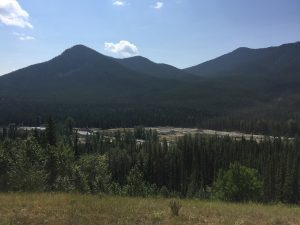An MLA for the Alberta Liberal Party is calling on the government to halt plans to log in the Kananaskis Country-area Highwood Pass.

David Swann said the NDP government is following in the footsteps of the previous government when it comes to logging in Alberta’s eastern slopes.
LISTEN: Alberta Liberal Party MLA David Swann on logging in the Highwood Pass
The Ministry of Agriculture and Forestry said in a statement on Tuesday that it is “committed to protecting and improving” the environment in Alberta and that it has taken a “sustainable approach to forest management.”
“Forest harvesting is conducted to resemble patterns of natural disturbances, like wildfire. It is conducted in a way that contributes to biodiversity and wildlife habitat,” the statement from Minister Oneil Carlier read.
In a letter to Swann, which he posted to the Alberta Liberal Party website, Carlier said Balcaen Consolidated Contracting Ltd. is permitted to harvest its full timber quota in a “single season” under the province’s Timber Management Regulation.
The vice president of Woodlands-Spray Lake Sawmills, the company that holds the Forest Management Agreement for the area, said Thursday that logging being done in Alberta forests is not clearcutting in the “traditional sense.”
Ed Klucsar told News Talk 770 that cuts occur in blocks ranging in size from one to 100 hectares in size.
“You need to do a range of cuts to get that range of age classes,” Klucsar said. “Because, there’s certainly different wildlife species that prefer younger open forests and there’s others that prefer forests of different ages.”
But environmental groups like Yellowstone to Yukon say extensive logging would be devastating to the Highwood Junction area, which it called a sensitive watershed.
“Trees are essentially sponges that soak up water over the course of the summer and without them you end up with floods in the spring and drought later in the summer and the fall, when you need the water most,” said Stephen Legault, program director for the Crown Alberta and Northwest Territories for the Yellowstone to Yukon initiative.
Klucsar said that “slash”, or debris left over following harvesting, actually retains all the nutrients on site.
“It provides for moisture conservation, having that slash out there, especially with our Chinook winds. It helps retain soil properties and the logging benefits certain species of wildlife as well,” he said.
Legault said concern is growing among conservation groups like his, as logging is slated to begin in September.
“We’re very concerned time is against us,” he said.
Swann added the Highwood Pass is an area that has “tremendous tourism and recreation value” and urged the minister to visit the land in question.
“I don’t know if he’s visited the area, but I think if he did, he might have a reason to pause and think about what some alternatives are here.”
The Alberta government admitted clearcutting does “result in a temporary change in the visual character of the landscape” but said that because lodgepole pine need full sunlight to regenerate, other methods would “hinder reforestation efforts.”
It said companies are required to report reforestation activity a minimum of three times after logging occurs and submit a performance survey 14 years after clearcutting and reforestation.
Kluscar said Thursday the first signs of regrowth appear not long after harvesting with vegetation, wildflowers and tree seedlings appearing “quite quickly within the first 10 years.”
He said his company plants three million seedlings a year to “supplement reforestation.”
However, both Legault and Swann have suggested selective logging would be a better option for the area as it “better mimics the natural processes that would naturally occur on the landscape.”
WATCH BELOW: Rally in K-Country to protest clearcut logging by Spray Lakes Sawmills
“What we’re actually doing right now is making things much more dangerous for fire and floods, and what we should be doing is thinking about: How do we make this landscape feel and look and respond ecologically more like it did hundreds of years ago, before we intervened on the landscape?” Legault said.
“If we want to protect our water source and if we want to protect ourselves from the risk of wildfire, we need to change the way we log on the eastern slope.”








Comments